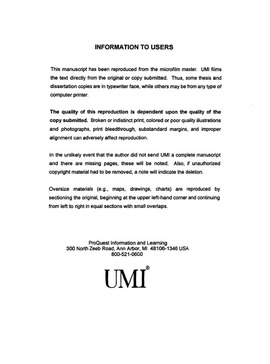| dc.contributor.advisor | Crawford, Kenneth, | en_US |
| dc.contributor.author | Tribble, Ahsha N. | en_US |
| dc.date.accessioned | 2013-08-16T12:18:57Z | |
| dc.date.available | 2013-08-16T12:18:57Z | |
| dc.date.issued | 2003 | en_US |
| dc.identifier.uri | https://hdl.handle.net/11244/595 | |
| dc.description.abstract | The power utility industry has become highly volatile with a deregulated market on the horizon and with enormous profit and loss swings in the energy trading market. Electricity, in particular, has become a commodity that is bought and sold at market prices, where load forecasting plays a crucial role in the composition of those prices. Public and private utilities must contend with the fact that a small error in an electric load forecast can create a large financial loss for the company. Hence, improving the accuracy of electricity load forecasts has become necessary for the long-term viability of all power utilities. | en_US |
| dc.description.abstract | This study used electric load data from four substations in Oklahoma and concurrent weather observations from co-located Oklahoma Mesonet sites to: (1) determine the interrelationships between weather variables and electric load demand; (2) determine the impact of weather on the consumption of electricity by different customer classes (e.g., residential, commercial, industrial); (3) establish thresholds of temperature associated with changes in the patterns of the use of electricity; and (4) produce load model simulations to quantify the improvements in the accuracy of a load forecast. This study also links a much improved, high-resolution numerical weather prediction model to a neural network load model to quantify the economic value of improved accuracy in load forecasts. In the end, this dissertation determined that a comprehensive understanding of the relationship between weather variables and electricity demand will improve the accuracy of load forecasting. The results of this study can save a small utility in excess of $0.5 million annually. If the results are applied to the larger power companies around the United States, a decrease in operating costs could exceed millions of dollars. | en_US |
| dc.description.abstract | Weather has a significant impact on load demand and load forecasting. However, the weather-load relationship is unknown at the substation-level---mostly because substation-level load data have rarely been available to those outside the corporate infrastructure. Equally as important, most utilities have made inconsistent and antiquated use of weather data. | en_US |
| dc.format.extent | xviii, 221 leaves : | en_US |
| dc.subject | Temperature. | en_US |
| dc.subject | Physics, Atmospheric Science. | en_US |
| dc.subject | Weather forecasting Oklahoma. | en_US |
| dc.subject | Engineering, Industrial. | en_US |
| dc.subject | Electric power consumption Oklahoma. | en_US |
| dc.title | The relationship between weather variables and electricity demand to improve short-term load forecasting. | en_US |
| dc.type | Thesis | en_US |
| dc.thesis.degree | Ph.D. | en_US |
| dc.thesis.degreeDiscipline | School of Meteorology | en_US |
| dc.note | Adviser: Kenneth Crawford. | en_US |
| dc.note | Source: Dissertation Abstracts International, Volume: 64-03, Section: B, page: 1292. | en_US |
| ou.identifier | (UMI)AAI3082952 | en_US |
| ou.group | College of Atmospheric & Geographic Sciences::School of Meteorology | |
